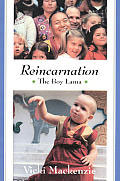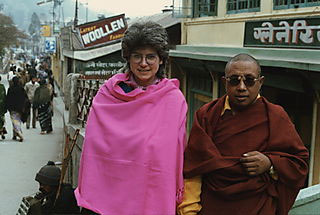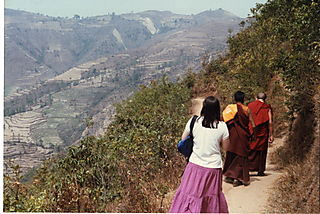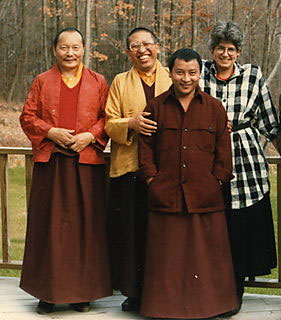March 29, 2008
With Tibet in the news recently, I thought I’d expand on a piece I have on my website about my cousin Zina Rachevsky and my travels in Nepal.
Zina Rachevsky
In the 1980′s I lived in Woodstock, NY, practically in the shadow of the Tibetan Buddhist Monestary Karma Triyana Darmachakra (KTD). Although I was not a practitioner, I lived with one, which I thought gave me some in-law status.
In 1983 or 1984, my partner and I decided to go to India and Nepal. She wanted to see the Lamas and Tibetan Buddhist shrines and I was in search of information about my cousin Zina Rachevsky, who, it is told, had been the first foreigner to study with Tibetan Lamas, (or second after Alexandra David Neel.)
Zina and her family had always been somewhat of mythical figures in my family. For one thing, the Straus family was fabulously wealthy. In 1921, Simon William Straus – (Zina’s grandfather, my grandmother’s brother) founder of SW Straus & Co., held loans on new buildings across the us worth $150,000,000. (NY Times, Dec 3, 1922) In 1924 they completed construction on the Chicago building that is now known as Metropolitan Tower, the first Chicago structure taller than thirty stories. It was then known as “The Straus Building.” SW Straus owned the Ambassador Hotels in Los Angeles, New York City and Atlantic City. He died in 1930. The company went into recievership, it went under, in 1932 after defaulting on bonds totaling over $200 million.
Zina was born in 1930, the same year her grandfather died. Zina was known to us a wild child, but in the 1950′s, when I was a child listening to the stories, that could be another way of speaking of an independent, curious woman. She spent much of her early adulthood working as actress and gaining a reputation as an international socialite, knew the Beat Poets, and eventually made her way to India and finally to Dharma.
Zena’s father, we knew, claimed Russian nobility. While the Russian nobility fable is a large part of Zina’s current mythology, in my family we were more interested in our side, the Jewish side. Zina’s mother and my mother were first cousins. Zina’s grandfather and my my grandmother were siblings. They were all German Jews, who had been in the United States since the middle of the 19th Century, and had made their fortune first as peddlers, then as bankers with huge real estate holdings throughout the country. They settled first in Ligonier, Indiana, creating one of the first and largest Jewish communities in the midwest. The family then moved on to Chicago and then to New York.
Zina, in the stories written about her, is usually referred to as a Russian Princess. It is not likely that Zina actually thought of herself as a Russian Princess. Certainly the rest of the family knew that her common-born father’s common-born sister had married a dethroned Russian Duke, which doesn’t equal royalty by any inheritance laws anywhere. Not a drop of royal blood coursed through her veins. However, it was a clever way of branding herself when she was creating a name for herself as an actress and a showgirl. The meme seemed to have stuck with her friends and acquaintences and became part of her public persona. Certainly, it made her memorable, and most likely reduced the amount of anti-Semitism that might have been an obstacle in those days.
Update: It turns out, in fact, that the Russian Rachevsky’s were most likely Jews as well. Converted to Catholicism, for various reasons, but Jews. Did Zina know this? I don’t know. But it seems that she was, by blood, 100% Jewish.
I didn’t think much about Zina until I became interested in Tibetan Buddhism. She had visited us in New York only once, but I had no memory of her. But when I found that Zina had been involved with Lamas in India and Nepal soon after the Chinese invasion of Tibet, I knew it was something worth investigating.
In 1965 Zina was in India, and, according to “official” versions she asked Lama Yeshe and Lama Zopa instruct her in Tibetan Buddhism. On the other had, I recently interviewed someone (who prefers not to reveal his name or sources publicly) who told me that while Zina was searching for a teacher, the two lamas heard about the wealthy American in town and courted (my informant actually said “hijacked”) her for her money and European/American resources. At any rate, they had never taught a foreigner before, there was no precedent for it, but they began to teach her. Zina brought more and more European and American students to study with them. Soon she bought land and founded a retreat and study center at Kopan in Nepal. Some versions of the story say that Zina wanted to start a nunnery but the Lamas opposed her and started the retreat center instead. She had the money but they had the Buddhist /political connections.
 Excerpt from Reincarnation:The Spanish Boy Whose Destiny was to be a Tibetan Lama by Vicki Mackenzie, Wisdom Publications 1996 : This narrative tells the, by now, “official” version of the Zina/Zopa/Yeshe story. Is it true? Possibly some of it is. Much of it not.
Excerpt from Reincarnation:The Spanish Boy Whose Destiny was to be a Tibetan Lama by Vicki Mackenzie, Wisdom Publications 1996 : This narrative tells the, by now, “official” version of the Zina/Zopa/Yeshe story. Is it true? Possibly some of it is. Much of it not.
“One day in 1965 an extraordinary thing happened. (to Lama Zopa and Lama Yeshe) Into their room burst the most unlikely figure of all. A beautiful, young, blonde ‘princess’ of Russian descent, by the name of Zina Rachevsky. She was looking for the Domo Geshe Rinpoche, no doubt inspired by the romantic figure of Lama Govinda’s book, and was taken by mistake to Lama Zopa, who was also known as Domo Rinpoche ever since his stay at Dung-kar monastery in Tibet. Unaware of the mistaken identity she strode forward and boldly ask: “How can I receive peace and liberation?”
“To say the two lamas were startled would be an understatement. No foreigner, especially the dreaded western ‘barbarian’ had ever entered their quarters before. No ‘barbarian’ had ever spoken to them like that before. And certainly, no ‘barbarian’ had ever talked of wanting enlightenment.
“But then Zina Rachevsky was no ordinary person. Her life was, in its way, every bit as extraordinary as the two lamas’. Her father was a Russian prince, a Romanov who had fled the Russian Revolution, her mother an heiress, one of the richest women in the United States. Zina was brought up in Hollywood, and became a typical product of Tinsel Town – spoilt, precocious, insecure, attention-seeking, deeply unhappy. By the time she was a teenager she’d already hit the headlines more than once, not only for her entrée into the world of starlets, but also for her involvement in various drug scandals. She was gorgeous, curvy, sexy, a Marilyn Monroe lookalike, wild and determined to live on the edge…
“By the time she met Lama Yeshe she was, quite bluntly, jaded. The drugs, alcohol, late nights, rich living and too many sexual entanglements had taken their toll. To the lamas, she must have justified their countrymen’s every prejudice about the degenerate, unspiritual, western devil. And so for a while they said nothing, merely looked.
“Was she real? Was she a fraud? Or was she, as Lama Yeshe suspected, someone very special? With his more mature wisdom he decided to test her. He explained to me: “I gave her some sort of answer, with my limited English, and after an hour she said she had to leave. To my surprise she asked if she could return the next day. I said “all right”. And she did come and asked more questions, and I gave teachings. For one week she made the journey by jeep to see us, and then asked us if we’d be prepared to go and visit her.”
“Lama Yeshe hesitated for a moment. The step he was about to take was irrevocable. At this point Lama Zopa stepped in. With all the zeal of his youthful Bodhisattva’s heart he begged Lama Yeshe over and over again not to forsake this woman who had come seeking his help. Lama Yeshe still demurred. Did Lama Zopa know what he was asking? Could he be aware of the enormous responsibility that they were about to initiate and which would one day fall solely on his shoulders? Was he prepared for all that was on the verge of being brought into effect?
“But the Bodhisattva promise, which they had both taken, is not written in sand, which the tide can wash away, but hewn out on rock and stands for all time. They both knew, of course, they could not refuse anyone sincerely seeking the truth. And so Lama Yeshe and Lama Zopa set the wheel of Dharma turning for the West, and daily for nine months gave Zina Rachevsky the teachings she so earnestly desired. It must have been a mutually fascinating exchange. If Zina was intrigued by the holy men she had stumbled upon, they must have been transfixed by her. As Lama Yeshe told me, “She was very dissatisfied with everything! She said her life was empty and had no ‘taste’. She’d done everything in life, but still could find no satisfaction. I could see what she was saying. In comparison I had nothing – no country, no home, no money, no possessions, no family, and yet I had everything. With Zina, and later with other westerners, I began to enquire about their lifestyle. I realized that what Zina lacked was an understanding of herself, her inner life. She lacked an understanding of her own potential to be happy. She thought happiness came from without, but it does not, it comes from within.”
“Zina had finally found the meaning that had been lacking in her frantically sad life. When her nine months of private tuition were over, the expiry of her visa forced her to return to Sri Lanka. She then bombarded the Dalai Lama with letters entreating him to give Lama Yeshe and Lama Zopa permission to visit her in Sri Lanka. When permission was granted, Zina returned to India to escort her lama, but on the spur of the moment decided to go with them first to Dharamsala to try and get an audience with His Holiness personally. Once there she became convinced that her true vocation was to become a nun. Again Lama Yeshe stopped in his tracks. Having a western female disciple was one thing, having one with a shaved head and red robes was another. “I thought about it for a while,” he admitted, “then decided it was all right! It even seemed like a good idea. So I asked the Dalai Lama personally if he would ordain Zina.” Vickie MacKenzie
I am intrigued that Zina’s story is told with such an air of authority, but still manages to get things wrong. Zina’s father was not a prince. He was a common born brother -in law- to the Grand Duke Boris. He and Harriet married twelve years after the Russian Revolution. Probably he was broke, and expected Harriet to supported him. They married in 1929, SW died that year, and the family lost their fortune during the depression.
The “official” story by MacKenzie and others also ignores the possibility that the Lamas were using Zina for her wealth. They are written to make the Lamas appear pure and noble, and Zina miserable and spoiled and then redeemed by Buddhism. (“With all the zeal of his youthful Bodhisattva’s heart he begged Lama Yeshe over and over again not to forsake this woman who had come seeking his help.”) Not that Zina didn’t want to study Buddhism, I’m sure she did. But it seems to me that they were as dazzled and interested in her “royalty” and money as they were in the possibility of teaching a foreigner. Either way, there is no proof, only the stories that are told and retold.
As to Zina’s “frantically sad life”? Harriet and her sisters all had a reputation in our family for being over the top in their youth. But even within families people’s lives become myths, and our stories are recast as scandal and gossip. I would describe Zina as smart, driven, creative and adventurous. Why claim that she was “spoilt” “attention-seeking” and “deeply unhappy” as Mackenzie does? The problem with anecdotal history is that it easily becomes fable, and you don’t know what to believe. Who is casting her in this light? Vicki Mackenzie doesn’t cite her sources. I ask, in whose interest is it to portray Zina as morally and spiritually deficient and the Lamas as noble and pure?
I did my early research on Zina without the aid of the internet or google – they didn’t exist yet. I relied on information from my relatives. Now Google searches lead to endless variations on the theme of the spoilt unhappy Russian princess begging for the teachings Lama Yeshe and Lama Zopa, beginning the trickle that became a wave of Westerners studying Tibetan Buddhism.
In 1983 (or 1984) I visited Kopan, the retreat center she founded, looking for people who had known Zina. With much difficulty I did find a couple of people willing to speak to me, but so reluctantly that I decided not to pursue it further. I puzzled over their reluctance to discuss Zina. If she had founded the center, surely someone would be willing to discuss her, tell me about her time there, her role in the founding. But to the contrary, people shunned me. People said, “someone else knew here but he’s not here,” or “he’s here but he’s busy,” or “nobody here knew her.” It felt wrong. I had the distinct sense I was being lied to, or purposefully avoided. I couldn’t figure out why, or even if it was true, since it was just my feeling. I decided to drop my investigations because I kept bumping into walls of silence. It was only after another two decades that I began my investigation again.
Zina died in the early 1970′s halfway through a meditation retreat, possibly of peritonitis, and supposedly enlightened, leaving her young daughter to be raised by her grandmother, Harriet. Her son, Alex, was with his father Conrad Rooks, the filmmaker who directed the 1972 film, Siddhartha. Alex is now also a filmmaker.
Harriet, Zina’s mother, whose family had fabulous wealth and lost all of it, died Los Angeles in the nineties, having raised Zina’s daughter. Zina’s Russian dad – I don’t know what happened to him.
I’m sorry I never got to know my cousin Zina. I’m sure that this woman who went from young Jewish Princess to actress/showgirl to Beat traveler, to Buddhist pioneer must have been amazing . I love how full her story is, how complex. It is said that she has reincarnated as a Swiss boy. I hope our paths cross someday. Stranger things have happened.
See more about Zina and her family.
H.E. Kalu Rinpoche
While in Nepal we had the great fortune of meeting with H.E. Kalu Rinpoche, a venerable, powerful, and ancient Lama. (check this link for a fascinating interview with June Campbell about the inherent misogyny of the rinpoche/tulku system that underlies the transmission of power in Tibet.) He was sick in bed, but graciously invited us into his bedroom to talk to him with the help of an interpreter.
I told him that I really didn’t want to take refuge (a term for accepting Buddhism – not necessarily giving up your birth religion) because I could hear my Jewish Grandmother rolling over in her grave. Kalu Rinpoche pantomimed kissing a mezzuzah. I found that totally endearing. I then promptly kneeled into his wooden soup bowl, which for some reason was next to me, and spilled it all over the floor. Then my grandmother really started screaming at me. “This nice old Tibetan Rabbi has taken time from his sick bed to talk to you and you spill his soup??? Clean it up!” So, there was nothing I could do but take refuge. It was lovely. Really.
More Lamas
In our travels we depended on the kindness of Lama Norlha Rinpoche, an esteemed teacher living near Woodstock, NY. We stayed with his family at his mother’s house in Darjeeling. We arrived before he did, and our only address was a scrbbled note with the name of the street and the word, “petralpum” We sked our driver to go to Petrulpum, and after searching for about an hour we finally realized that it wasn’t “petralpum” one of us had transcribed Lama saying Petrol Pump. The house was located next to the petrol (gasoline) station. It wasn’t a gas station as we knew it, but it was the gasoline pump. So much for translating English into English.
Lama Norlha was always telling me I should do a three year retreat. I’m sure he was half joking, half not. While I loved meditating with him, there was just no way I was about to give up three years of my life for it. Maybe if I could have worn pink robes instead of maroon.
In Nepal spent time hanging out Trangu Rinpoche in Darjeeling. I know this sounds really casual, but it’s true. When the Lamas came to the States they were surrounded with ceremony and devotees. But back home, they were incredibly welcoming and relaxed. I think we had tea with Trangu Rinpoche at his place several times. Just him and the two of us.
One day Trangu Rinpoche invited us to go on an expedition with him. This involved taking a long trip on a very dusty road in an old auto that broke down. We ended up joining a group of people in a rikety old bus after hiking for miles. The bus was fine, and actually rather fun, but the roads were so dusty that we had to wrap our heads in our shawls just to be able to breathe. I have no memory of where we went.
When Trangu Rinpoche came to Woodstock later that year we invited him and some of the other Lamas to lunch at our house.
Khenpho Karthar Rinpoche was the abbot at KTD.
Bardor Tulku Rinpoche was teaching there as well. Here we are on my deck. That’s me in the Norma Kamali shirt with huge shoulder pads. Maybe I would actually have looked better in the maroon robes.
extracted from: http://seesaw.typepad.com/blog/2008/03/zina-rachevsky-jewish-princess-and-the-tibet-connection.html







3 Responses to “Zina Rachevsky – Jewish Princess and the Tibet connection”